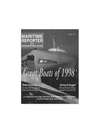
Page 32: of Maritime Reporter Magazine (January 1999)
Read this page in Pdf, Flash or Html5 edition of January 1999 Maritime Reporter Magazine
GREAT BOATS OF 1998
Fascination with speed — in all modes of transportation — is always tempered, though, with the need for safety and stability, ensuring that power and control remain hand-in-hand.
This is especially true in the maritime industry, which has significantly accelerated the issues of safety of ship, crew and passenger in recent years.
A significant debut of a new fast craft was at a New Orleans exhibition, at which Halter
Marine Group puts its innovative high-speed, low-wake E-CAT through its paces. The cata- maran passenger ferry (which follows an emerging trend of innovative paint jobs as well as technological advances) made a 40-knot plus debut during the International Marine Transit
Association (IMTA) conference.
The E-CAT is interesting in that its design was in part spawned by concerns raised over other large high-speed vessel designs.
Designed in cooperation with the U.S.
Defense Advanced Research Projects Agency
MARITECH program, the twin-hulled, all-alu- minum vessel is designed for cost-effective, high-speed ferrying of passengers in wake sen- sitive areas such as that found on rivers, water- front environments and recreation areas. "The flexible E-CAT design can be easily con- figured to meet customer requirements from 250 to 450 passengers...with speeds reaching 40 knots," said Halter Marine president and CEO
John Dane III.
The prototype E-CAT particulars follow:
Length 148 ft. (45.1 m)
Width 38 ft. (11.5 m)
Draft, design 4 ft. (1.2 m)
Main engines Caterpillar 3516B
Waterjets Bird Johnson
Gears Reintjes
Range 500 nm
Classification ABS
Halter's already stellar reputation among the advanced fast ferry builders of the world has grown substantially of late, capped with the announcement that it and Empresa Nacional
Bazan de C.N.M., S.A. of Madrid, Spain had formed Halter-Bazan, a joint venture to build
Bazan-designed aluminum passenger/vehicle fast ferries (the Alhambra class) at the Halter facility. Construction of a 410 ft. (125 m), 1,250- passenger/240-vehicle vessel for an unnamed customer is reported to begin next month, and negotiations on a similar vessel are currently underway. Halter will also build Bazan's
Mestral class.
Partnerships — on all levels of all industries — is flourishing, and the fast ferry segment of the marine market is no exception. Hellenic
Shipyards Co. and Rodriquez Cantieri Navali
S.p.A. signed a cooperation agreement last
October which produced the framework for an agreement for the promotion and construction of the Rodriquez Cantieri Navali design hydro- foils and the Aquastrada line of ferries. The
Aquastrada Ferries have proven to be excep- tionally stable and productive, even in adverse weather conditions, and Hellenic is touting the vessel as not only competing with other fast fer- ries for the carriage of passengers, but compet- ing with all other modes of transportation — including road and air — in deliver- ing speed, quality and convenient travel. The Aquastrada series is equipped with the Navigation
Seaworthiness Management
System — a computerized stabiliza- tion system designed to reduce pitch and vertical acceleration — and the vessels maintain speeds between 40-50 knots.
Dressed To Go
Higher speeds have upped the technological ante, in terms of the delivery of a product which will not only break records at sea trials, but remain a valuable, money-making portion of a given owner's fleet.
No doubt, the stresses and strains on hull and machinery is greater at 50 knots than 20, but for seasoned maritime outfitters, it is a mere matter of engineering the solution to fit the challenge.
For example, Maritime Dynamics of
Lexington Park, Md., has responded to the demand for fast speeds and light hulls by undertaking an extensive product assessment to address these concerns. The result, accord- ing to the company, is several weight saving features which will be incorporated into the company's highly regarded ride control system.
The first measure has been to design the ride control hydraulics system to operate other onboard equipment. Now Maritime Dynamics offers hydraulic packs which, in addition to the ride control system, operate the propulsion waterjet steering and reversing system. During docking operations, they can be utilized for car ramps, capstans and anchor winches. This summer, Maritime Dynamics is scheduled to install its first commercial computer-based ride control system with an embedded Microsoft
Windows operating system. The system will offer touch screen operation, as well as improved diagnostics, and easy integration with alarm and monitoring systems. Maritime
Dynamics ride control system references include Incat's wave-piercing catamaran Hull 050 (see story, page 37), Trico Marine's SWATH
Stillwater River (see story, page 43); Derecktor
Shipyard's Ernest Hemingway; and
Fincantieri's Superseacat III and IV.
Litton Marine Systems scored an unusual double score this past summer, when the trans-
Atlantic speed record was broken twice. Both
Incat-built vessels — Catalonia which averaged 38.85 knots and Cat-Link V, which averaged 41.284 knots — featured Litton Marine System electronics. Both ships feature an integrated package of two Litton LMX 406 DGPS receivers and two HSC Decca BridgeMaster II 250 series navigation radars, which are designed specifi- cally to meet the requirements of high-speed craft. The S-band and X-band radars are fully
While small relative to the whole, the fastferry niche ofthe mar- itime market is a glamour side of the business which allows designers, builders and equipment makers to experiment and expand lines of equipment and thinking in regards to high per- formance. For those that doubt that speed brings out "the wild side," think of the last time a VLCC was painted to resemble a
Tasmanian Devil, as the Alstom RK270-powered, Incat-built
Tasmanian Devil was (pictured to the right).
The Incat Tasmanian Devil, powered by the Alstom RK270 20-cylinder engine, achieved more than 5 knots in light conditions on its first day of trials.

 31
31

 33
33
